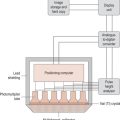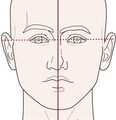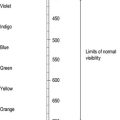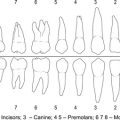K
K-space the space that is filled with information and undergoes Fourier transformation to form a magnetic resonance image. By manipulating the K-space, faster sequences can be implemented.
Kaposi’s sarcoma neoplasm characterized by new blood vessel growth producing red, purple or brown lesions, often on the skin, may metastasize to the lymph nodes and viscera. Originally common in Africa but now often seen in immunocompromised individuals, for example, those with acquired immunodeficiency syndrome (AIDS).
karyorrhexis disintegration of nuclear chromatin.
Keller’s operation for hallux valgus or rigidus. Removal of the proximal half of the proximal phalanx, plus any bone growths (osteophytes) and bony outgrowths (exostoses) on the metatarsal head. The toe is fixed in the corrected position; after healing a pseudarthrosis results.
keloid an overgrowth of collagenous scar tissue at the site of a skin injury.
Kelvin the unit of thermodynamic temperature.
keratin a fibrous protein found in nails and the outer part of the skin and horns, etc.
keratitis inflammation of the cornea.
keratoacanthoma a benign, rapidly growing, flesh-coloured nodule on the skin with a central plug of keratin. The tumour is most common on the face, back of the hands and the arms.
kerma kinetic energy released per unit mass of an absorber, unit joules per kilogram or grays.
ketonaemia ketone bodies in the blood.
ketones organic compounds (e.g. ketosteroids) containing a keto group. ketone bodies include acetone, acetoacetate (acetoacetic acid) and β-hydroxybutyric acid produced normally during fat oxidation. Can be used as fuel but excess production leads to ketoacidosis. This may occur when blood glucose level is high, but unavailable for metabolism, as in poorly controlled diabetes mellitus.
ketonuria ketone bodies in the urine.
ketosteroids steroid hormones that contain a ketone group. The 17-ketosteroids are excreted normally in urine and are present in excess in overactivity of the adrenal glands and the gonads.
keV the energy given to an electron when passing through a potential difference of 1 kilovolt in a vacuum.
keyboard a microprocessor with a range of keys which when depressed send an electrical code to a computer which then displays the appropriate image on a monitor or carries out an appropriate action.
kidney paired retroperitoneal organs situated on the upper posterior abdominal wall in the lumbar region. Help to maintain stability by producing urine to excrete waste such as urea, control water and electrolyte balance and blood pH. They also secrete renin and renal erythropoietic factor (REF) and are involved in vitamin D metabolism.
kidney failure inability of the kidneys to maintain normal function. See also renal failure.
kidney function tests a series of tests that include: routine urine testing, urine concentration/dilution tests, serum urea and electrolytes, serum creatinine and renal clearance to estimate glomerular filtration rate (GFR).
kidney machine (artificial kidney) the machine used to remove waste products from the blood in the case of renal failure. See also dialyser.
kidney transplant surgical transplantation of a kidney from a previously tested suitable live donor or a donor who has recently died. Kidneys may also be transplanted from the renal bed to other sites in the same individual in cases of ureteric disease or trauma.
killers impurities added to the intensifying screen crystal to control after-glow.
kilogram (kg) one of the seven base units of the International System of Units (SI). A measurement of mass.
kilojoule (kJ) a unit equal to 1000 joules. It is used to measure large amounts of energy. It replaces the kilocalorie (kcal) which is still commonly used. See also calorie.
kilovoltage treatment unit radiotherapy units operating in the region of either 50–150kV for the treatment of external, superficial lesions or 150–300kV for treatment of metastatic bone lesions and some primary bone lesions.
kinase an enzyme activator that converts a zymogen to its active form. Enzymes that catalyse the transfer of a high-energy group of a donor, usually adenosine triphosphate (ATP), to some acceptor, usually named after the acceptor (e.g. fructokinase).
kinetic relating to or producing motion.
kinetic energy the energy which a body possesses by virtue of its motion, unit joule.
Kirschner wire a wire drilled into a bone to apply skeletal traction. A hand or electric drill is used, a stirrup is attached and the wire is rendered taut by means of a special wire-tightener.
Klumpke’s paralysis paralysis and atrophy of forearm and hand muscles, sometimes caused by birth injury.
klystron a microwave device which amplifies the power of radiofrequency radiation. When used with a radiofrequency driver it acts as the radiofrequency power source in some linear accelerators.
knee the synovial condylar joint formed by the lower end of the femur and the tibial condyles and the patella with the patellar articular surface of the femur.
knee jerk a reflex contraction of the relaxed quadriceps muscle caused by a tap on the patellar tendon: usually performed with the lower femur supported behind, the knee bent and the leg limp. Persistent variation from normal usually signifies organic nervous disorder.
knuckles the dorsal aspect of any of the joints between the phalanges and the metacarpal bones, or between the phalanges of the hand.
K°hler’s disease osteochondritis of the navicular bone. Confined to children of 3–5 years.
Korotkoff sounds the sounds audible when recording non-invasive arterial blood pressure with a sphygmomanometer and stethoscope. The phases are: (1) a sharp thud – systolic pressure, (2) a swishing sound, (3) a soft thud, (4) a soft blowing that becomes muffled, (5) silence. Opinion is divided as to whether phase 4 or 5 should represent diastolic pressure.
Krebs cycle (citric acid cycle, tricarboxylic acid cycle) the final common pathway for the oxidation of fuel molecules: glucose, fatty acids, glycerol and amino acids. These enter the cycle as acetyl coenzyme A (CoA) and are oxidized to produce energy ATP (adenosine triphosphate), carbon dioxide and water.
Krukenberg tumour a secondary (metastatic) malignant tumour of the ovary, usually spread from primary stomach (gastric) cancer.
K°ntscher nail used for intramedullary fixation of fractured long bones, especially the femur. The nail has a ‘clover-leaf’ cross-section.
kVp the maximum kilovoltage applied across an X-ray tube in a forward direction during an exposure.
kypholordosis coexistence of kyphosis and lordosis.
kyphoscoliosis coexistence of kyphosis and scoliosis. May prevent proper lung expansion and respiratory problems.
kyphosis as in Pott’s disease, an excessive backward curvature of the dorsal spine. Commonly associated with osteoporosis.







